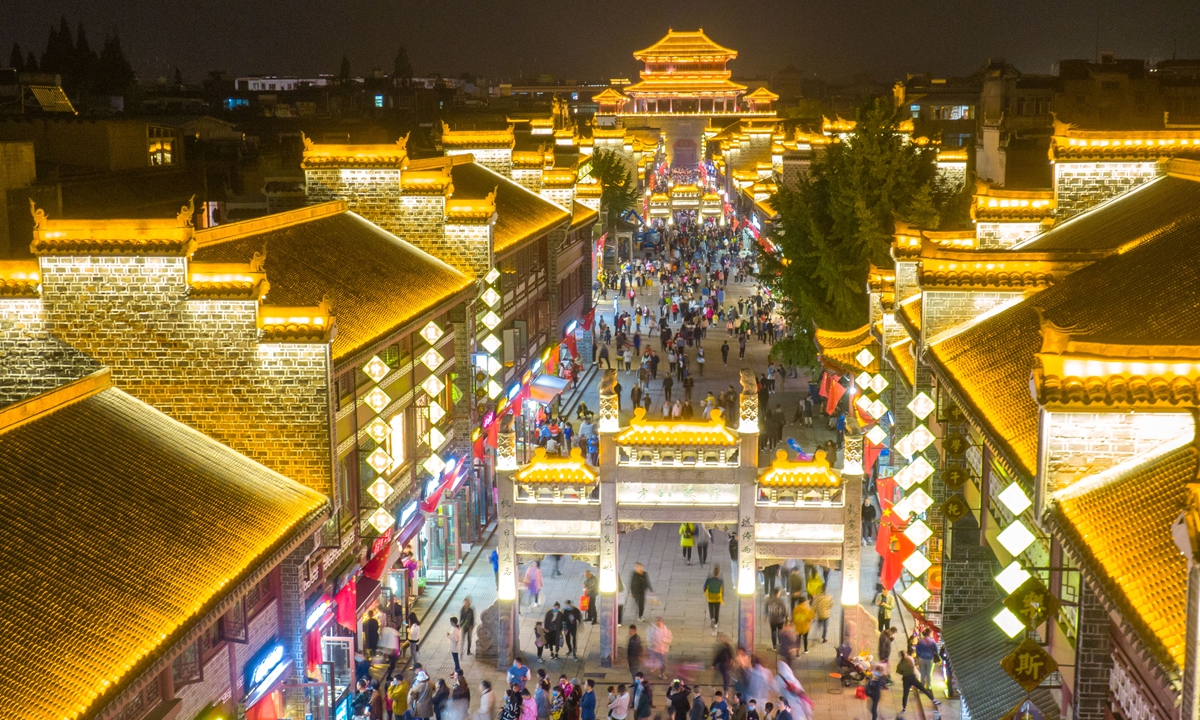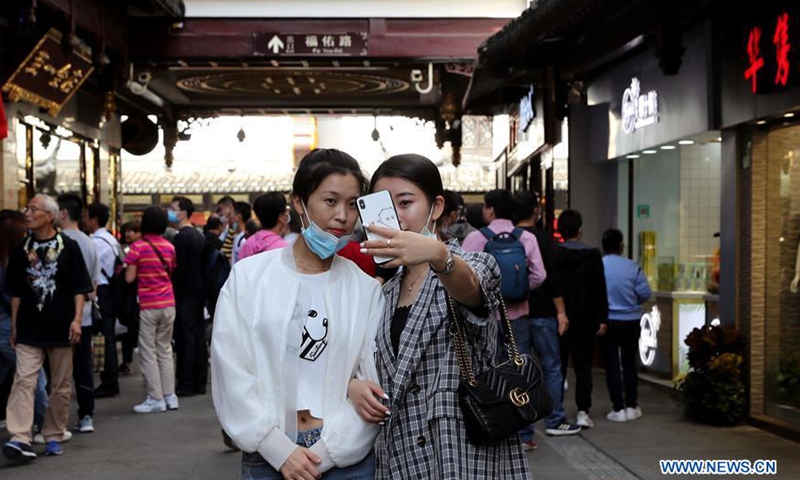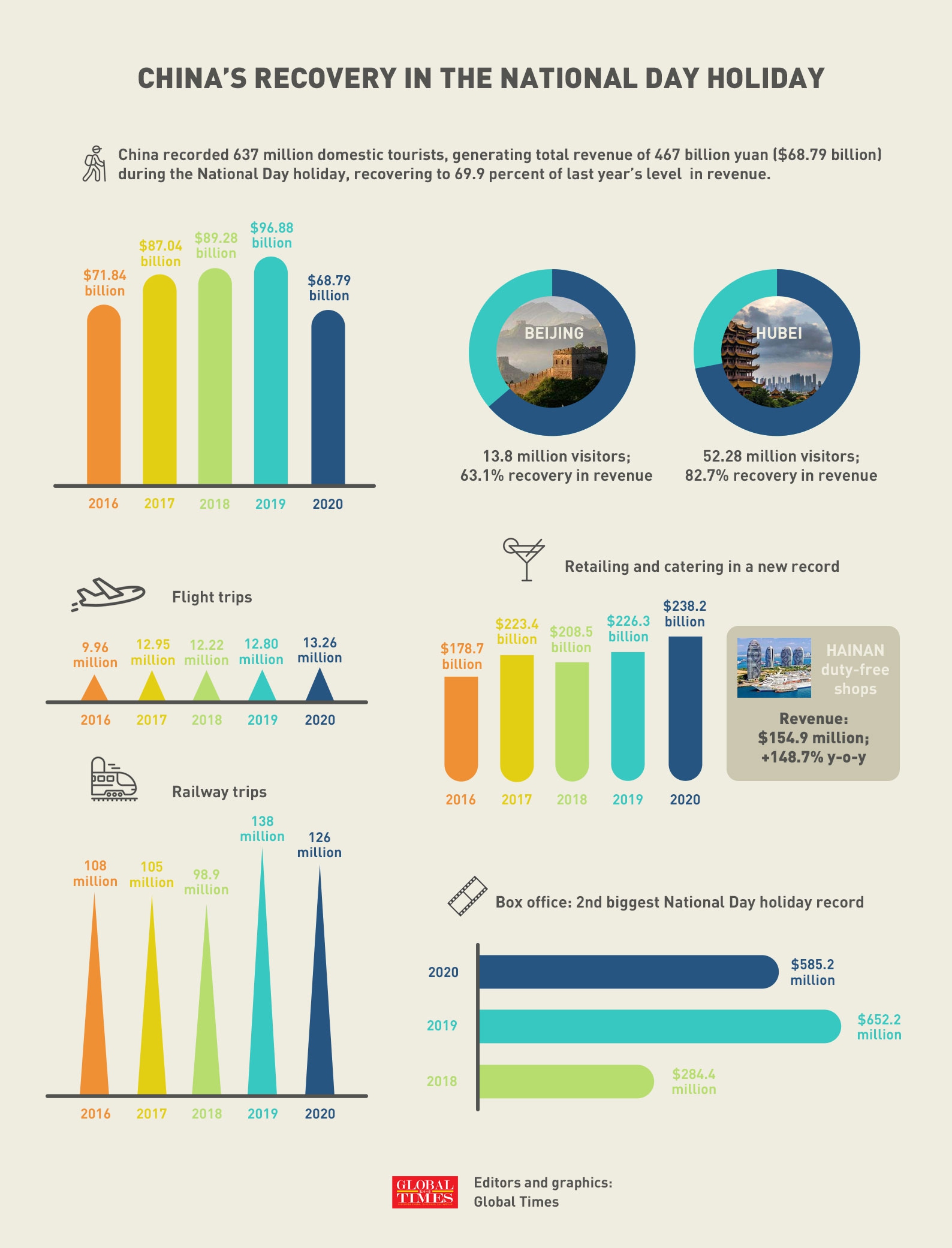Economy moves to second half with Golden Week boom
Positive data shows ‘history’ of virus disruption

Tourists in Xiangyang, central China's Hubei Province, during National Day. Photo: VCG
Nearly half of China was on the move during the recent eight-day "Golden Week."
Across the country, from the Yellow Crane Tower in Wuhan, capital of Central China's Hubei Province - the city put into lockdown for 76 days for epidemic prevention - to the Great Wall in Beijing, crowds were seen spanning miles across tourists sites.
On Friday, the first trading day after the holidays, Chinese A-shares posted an across-the-broad rally, shaking off the turbulent coronavirus blues. The benchmark Shanghai Composite Index was up 1.68 percent on Friday's closing, while the NASDAQ-style ChiNext gained 3.81 percent.
Those scenes would have been unimaginable several months ago, and they are the envy of most countries, which are still battling the second wave of the pandemic.
Industry observers and businesspeople said the eight-day holiday - which is regarded as a "bellwether" of China's economic development - marks a "watershed moment," as China's post-virus economic recovery moves into its second half.
The nation has been abuzz with consumption during the holidays, rebounding at a stunning speed. Data released by China's Ministry of Commerce show that major retailers and catering companies generated total sales of 1.6 trillion yuan from October 1 to 8, with daily revenue up 4.9 percent from the same time last year.
China also recorded 637 million domestic tourists during the holiday season, reaching 79 percent of last year's level. It was an improvement over the 48.81 million visitors during the three-day Dragon Boat Festival in June, which represented only 50.9 percent of last year's level.
Domestic tourism revenue reached 466.6 billion yuan, 69.9 percent of last year's level. During the Dragon Boat Festival, total revenue was 12.29 billion yuan, 31.2 percent of last year's.
During the May Day holiday from May 1 to 5, Chinese tourists made a total of 115 million domestic trips, down 41 percent from a year earlier.
"The revival is picking up, which bodes well for a steady recovery in the fourth quarter, as well as next year. It sends a signal that China's economy has withstood the COVID-19 'extreme stress test' after nine months of painstaking efforts, and has returned to near normalcy," Tian Yun, vice director of the Beijing Economic Operation Association, told the Global Times on Friday.

Tourists take selfies at Yuyuan Garden in east China's Shanghai, Oct. 8, 2020.Photo:Xinhua
Signs of revival
Huang Qian, owner of a 10-square-meter shop that sells tea and loquat leaf extracts in Suzhou, East China's Jiangsu Province, said he was "thrilled to tears" when he saw massive traffic jams, and the return of throngs of tourists.
"We sell local specialties that target tourists. My store was on the brink of collapse two months ago with people trapped in their homes. But the National Day holidays became a turning point for my business," Huang told the Global Times, noting that the Chinese government's swift anti-epidemic measures played an extremely pivotal role in the country's economic reboot.
The loquat leaf extracts at Huang's shop - priced at 50 yuan a bottle - were sold out as of Thursday, Huang said. Some visitors from nearby provinces were also buying tea "in bags," bringing in large amounts of revenue to help Huang blunt the epidemic fallout.
The hustle and bustle was not only in tourist spots, but also in shopping malls and supermarkets, from first-tier cities like Shanghai to less developed counties. Most gathering activities - like cinema-going - have returned to people's normal lives.
The country had also embarked on an "infrastructure construction spree" during the holiday period.
Visitors told the Global Times on Friday that one of the most impressive scenes in their trips to different cities was the humming excavators at construction sites, which were used to build factories, subways and properties.
It is expected that China's excavator sales would grow by over 60 percent in September, according to a report by the China International Capital Corporation.
"The positive data in consumption and fixed-asset investment shows that the COVID-19 pandemic's disruption to the country's economic activities is history. Growing economic vitality is seen," Mei Xinyu, a research fellow at MOFCOM's Chinese Academy of International Trade and Economic Cooperation, told the Global Times on Friday.
Analysts predicted that China's retail may return to positive territory in the fourth quarter, making the country the first, and probably only major economy in the world to record consumption gains in the fourth quarter.
In August, China's retail sales grew 0.5 percent, the first time growth had been recorded since the start of 2020.
This drive from consumption, together with online sales campaigns in the remaining months of the year, including the Double 11 shopping festival, should help the economy achieve a GDP growth of 7 percent in the fourth quarter, higher than the 6-percent growth in the fourth quarter of 2019, according to a report sent by the Zhixin Investment Research Institute to the Global Times on Friday.
That would translate to a full-year GDP growth of 2.7 percent.
For the third quarter, Mei estimated that China's GDP growth would be between 4 to 5 percent, before consumption growth picks up in the last quarter. China is scheduled to release economic data for the third quarter on October 19.
Analysts said one of the uncertainties for the remainder of the year is foreign trade, which is subject to how the COVID-19 is controlled on the global stage, as well as the US presidential election in November, which casts a dark shadow on the global economic outlook.
But one thing is for sure: China will buck the global economic downturn and serve as the main engine for the world economy this year. What's more, China will likely be the only major economy to record positive growth in 2020.
"The year 2021 is likely to embrace China's highest GDP growth in the past few years of around 8 percent," Mei said.




